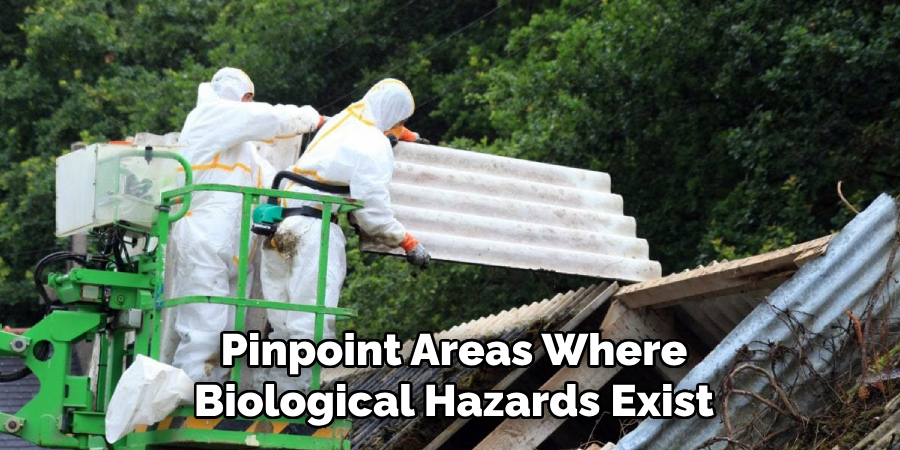Are you an employee working in the healthcare, laboratory, or agricultural industry? If so, you may be exposed to biological hazards at work. In this guide, we will discuss how to identify biological hazards at work.

Biological hazards, often referred to as biohazards, are risks posed by organisms or biological substances that can threaten employees’ health in the workplace. These hazards may include viruses, bacteria, fungi, other microorganisms, and biological substances such as toxins or allergens. Identifying biological dangers at work is essential to ensure the safety and well-being of all employees.
By recognizing the potential sources of biohazards and understanding the conditions that promote their presence, organizations can take proactive measures to mitigate risks and maintain a healthy work environment.
What Are the Causes of Biological Hazards?
Biological hazards can come from various sources, including humans, animals, plants, and environmental factors. Some common causes of biohazards in the workplace include:
- Exposure to infectious agents through contact with bodily fluids or contaminated surfaces
- Inhalation of airborne pathogens such as viruses or bacteria
- Ingestion of contaminated food or water
- Contact with animal waste or carcasses
- Exposure to toxic chemicals derived from biological sources (such as mold)
These hazards can be present in various industries, including healthcare facilities, laboratories, agricultural settings, and office buildings.
What Will You Need?
Before you start identifying biological hazards, having the necessary tools and equipment is essential. These may include:
- Personal protective equipment (PPE) such as gloves, masks, and gowns
- Cleaning supplies for disinfecting surfaces
- Biological hazard identification checklist or guide
- Access to safety data sheets (SDS) for all hazardous substances present in the workplace
Once you have these items, you can begin identifying biological hazards at work.
8 Easy Steps on How to Identify Biological Hazards at Work
Step 1: Conduct a Workplace Assessment

A workplace assessment is the first and most crucial step in identifying biological hazards. This involves thoroughly inspecting the work environment to pinpoint areas where biological hazards exist. Examine the facility’s layout, including high-traffic areas, storage spaces, and where materials or waste are handled. Pay close attention to locations where water or moisture is present, as these are prime conditions for mold growth and other microbiological threats. It is also essential to review work processes that involve direct contact with potentially hazardous substances, such as laboratory procedures, waste disposal methods, or the handling of raw materials in agricultural settings.
During this assessment, input from employees in these areas will be gathered daily. They can provide valuable insights into tasks or situations that pose biological risks. Document all observations systematically, noting specific hazards, their locations, and potential exposure routes.
Step 2: Implement Control Measures
After identifying and documenting biological hazards, the next step is implementing appropriate control measures to mitigate the risks. Start by prioritizing the dangers based on their severity level and likelihood of causing harm. Control measures can include engineering controls, such as improving ventilation systems to reduce airborne contaminants, or administrative controls, such as establishing strict sanitation protocols and training programs. Where necessary, provide personal protective equipment (PPE), such as gloves, masks, or protective clothing, to reduce direct exposure. Additionally, all employees should know the control measures and receive adequate training on using them effectively. Regularly monitor the effectiveness of these controls and make adjustments as needed to maintain a safe work environment.
Step 3: Monitor and Review
Once control measures are implemented, monitoring and reviewing their effectiveness is essential. Regular inspections, audits, and risk assessments should be conducted to ensure the measures function as intended and address the identified biological hazards. Collect employee feedback to identify any gaps or issues with the current controls. Documentation of observations and findings is crucial to track progress and make informed decisions about necessary updates. If new hazards are identified or workplace processes change, revisit the hazard assessment and revise control measures accordingly. This ongoing process ensures that the work environment remains safe and compliant with relevant regulations.

Step 4: Training and Communication
Effective training and communication are vital in managing biological hazards. Ensure that all employees are educated on the nature of the hazards they may encounter and the proper procedures to minimize risks. Provide training sessions on correctly using personal protective equipment (PPE), safe handling of materials, and emergency response protocols. Clear communication channels should be established to report hazards and discuss safety concerns. Regularly update employees on any changes to procedures or new hazards identified. Empowering the workforce with knowledge and fostering open communication cultivates a proactive safety culture in the workplace.
Step 5: Emergency Preparedness and Response
Developing and implementing an emergency preparedness and response plan is essential for addressing biological hazards effectively. This plan should outline clear procedures to follow in the event of an exposure, spill, or contamination incident. Train employees on these emergency procedures, including using personal protective equipment (PPE), containment strategies, and decontamination processes. Ensure that emergency contact numbers, first aid resources, and spill kits are easily accessible in critical areas. Regularly conduct drills to test the effectiveness of the response plan and make adjustments based on lessons learned. A well-prepared workplace minimizes risks and ensures a swift and coordinated response to biological hazard emergencies.
Step 6: Continuous Monitoring and Evaluation
Establishing a continuous monitoring and evaluation system is crucial for controlling biological hazards. Regularly assess workplace conditions to identify new risks or areas where existing controls may be insufficient. Implement routine inspections, audits, and biological sampling where applicable to ensure compliance with safety standards. Encourage employees to report potential hazards or unsafe conditions promptly. Use the data gathered from monitoring activities to review and update policies, procedures, and training programs. By fostering a proactive approach to evaluation, organizations can adapt to changing circumstances and maintain a robust safety framework.

Step 7: Employee Training and Awareness
Effective management of biological hazards relies heavily on employee training and awareness. Provide comprehensive training sessions to educate employees about the nature of biological hazards, their risks, and the measures to control them. Include practical components, such as using personal protective equipment (PPE) correctly, safe handling of biological materials, and emergency response protocols. Regularly refresh training to ensure knowledge remains current and incorporate feedback to address the workforce’s specific challenges. An informed and vigilant team is critical in preventing incidents and providing a safe workplace.
Step 8: Keep Up with Regulations
As with any aspect of occupational health and safety, staying updated with relevant regulations is crucial for managing biological hazards effectively. Regularly review and assess the organization’s compliance with applicable laws, standards, and guidelines. Conduct regular research to stay informed about emerging trends or changes in best practices for biological hazard management. Ensure that policies and procedures are regularly updated to reflect any new requirements. Compliance with regulations ensures a safe work environment and protects organizations from potential legal consequences.

By following these steps, organizations can effectively manage workplace biological hazards and safeguard their employees’ health and well-being.
5 Things You Should Avoid
- Ignoring Proper Training: Failing to provide employees with adequate training on identifying and handling biological hazards can lead to unsafe practices, increasing the risk of exposure in the workplace.
- Overlooking Risk Assessments: Skipping regular risk assessments can result in unidentified hazards, leaving workers vulnerable to biological threats that could have been mitigated.
- Not Wearing Appropriate Personal Protective Equipment (PPE): Neglecting to use or enforcing the use of PPE, such as gloves, masks, or protective clothing, can expose individuals to harmful biological agents.
- Improper Handling of Biohazardous Material: Mishandling biological samples, waste, or contaminated materials may spread hazards and put everyone at risk of infection or contamination.
- Neglecting Proper Cleaning and Sanitation: Failing to maintain a thorough cleaning and disinfection protocol can create an environment where biological hazards thrive, posing a danger to workplace health and safety.
What is the Symbol for a Biological Hazard?
The symbol for a biological hazard is typically a biohazard symbol, which consists of a triangular shape with three curved lines extending from the top. It is commonly colored bright orange or red to indicate danger and alert individuals of potential biological hazards.
This symbol can be found in containers, materials, or areas that risk exposure to potentially harmful biological agents. It serves as a reminder for individuals to handle these items cautiously and follow appropriate safety protocols.
The biohazard symbol was introduced in 1966 by Charles Baldwin, an environmental health engineer working for Dow Chemical Company. Since then, it has become an internationally recognized symbol for biological hazards and is used in various industries such as healthcare, research, and waste management.
Conclusion
How to identify biological hazards at work is critical for maintaining a safe and healthy environment for all employees.
To effectively identify these hazards, it is essential to conduct regular risk assessments, stay informed about the types of biological agents present, and ensure that all warning signs and symbols, such as the biohazard symbol, are displayed. Education and training play vital roles in helping employees recognize potential risks and follow proper protocols when handling biological substances.
By maintaining vigilance and adhering to safety guidelines, workplaces can mitigate the risks associated with biological hazards and ensure the well-being of their staff.

